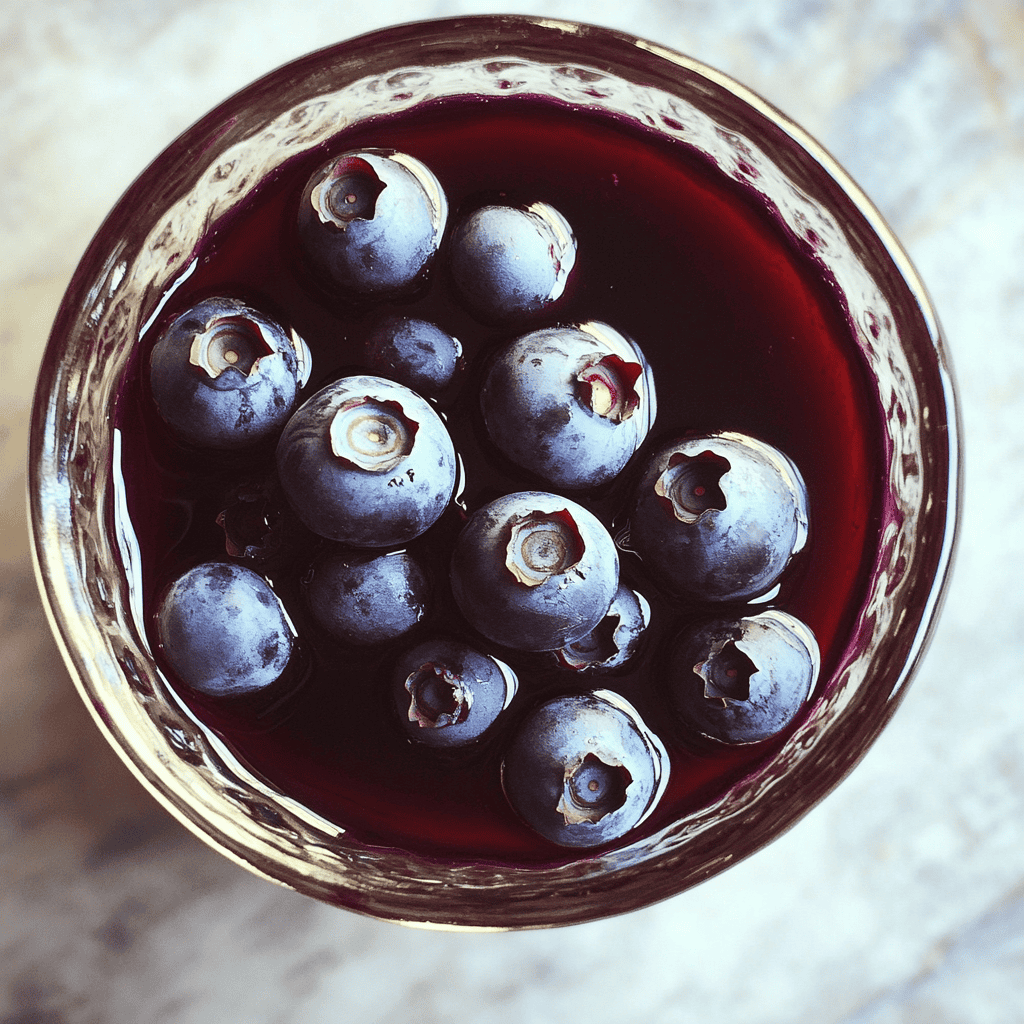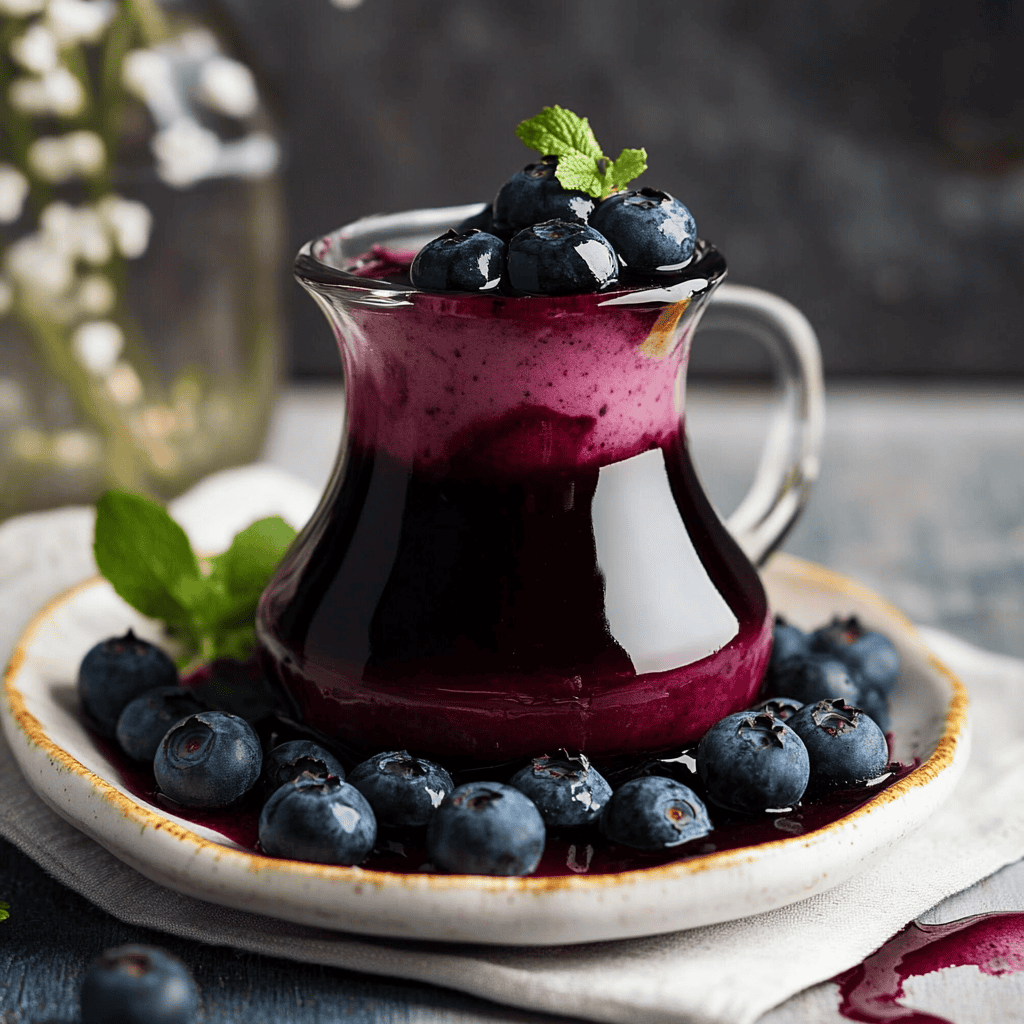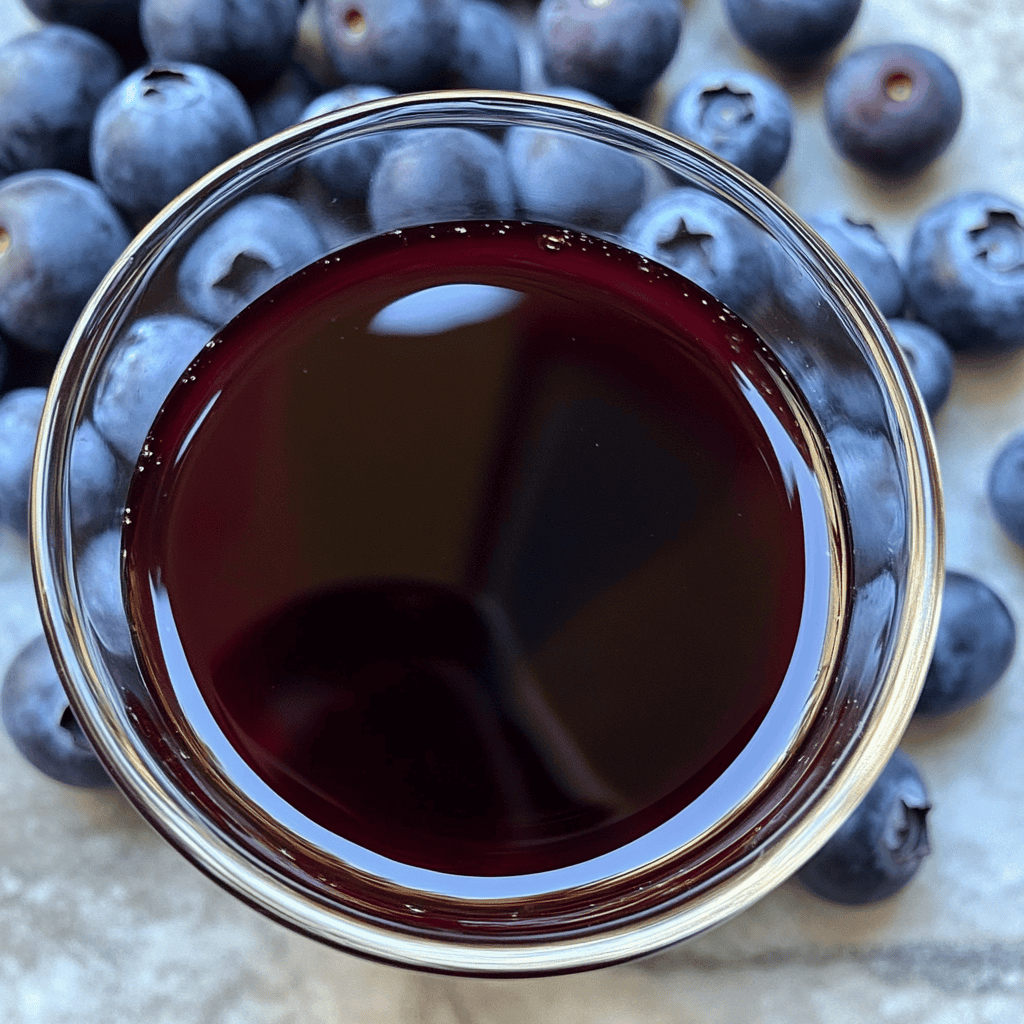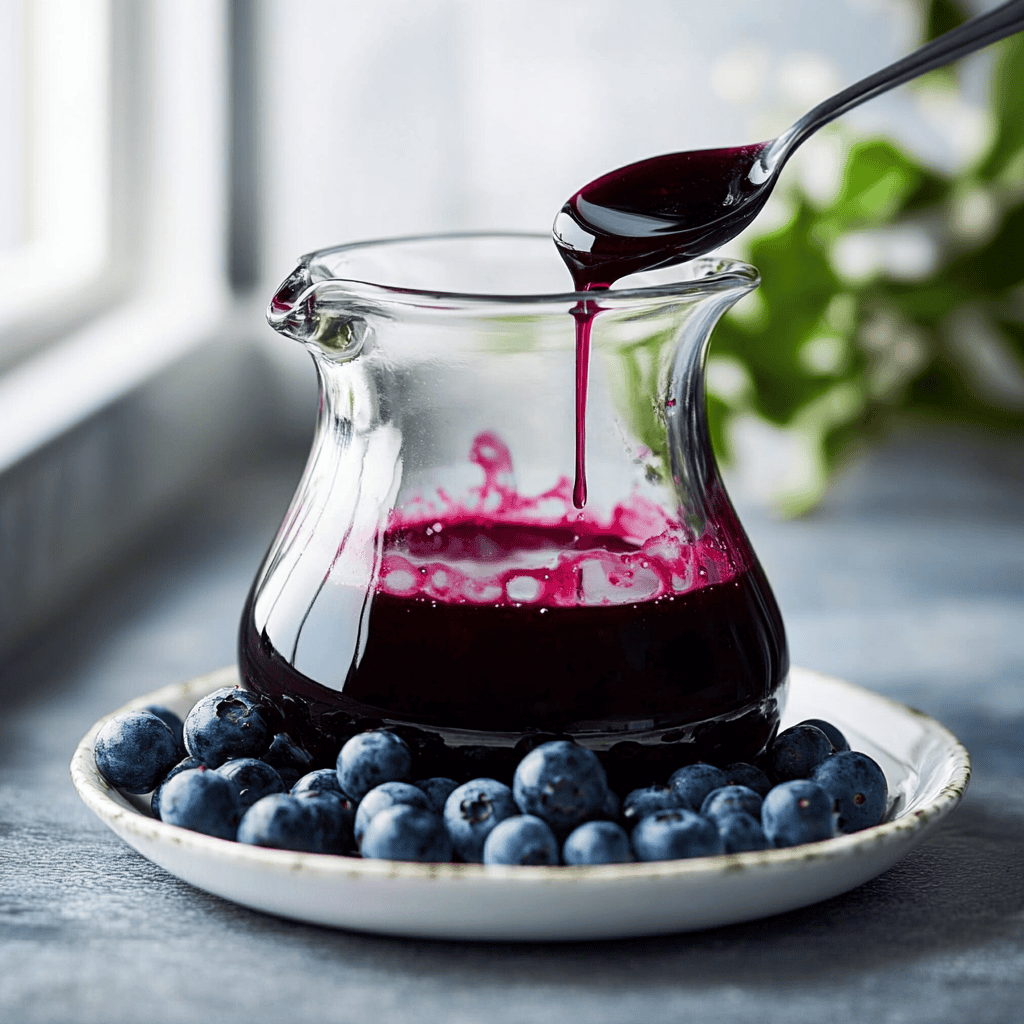Quick Overview
Blueberry syrup is a delightful topping that can transform your breakfast or dessert into something extraordinary. This easy-to-make syrup uses simple ingredients and brings a burst of flavor to pancakes, waffles, ice cream, and more. With its rich color and sweet taste, blueberry syrup is a favorite among many. In this article, you’ll discover how to create this scrumptious treat right in your kitchen.
Ingredient Breakdown
Fresh Blueberries
Fresh blueberries are the star of this recipe. You will need two cups of ripe blueberries for the best flavor. Look for plump, juicy berries that have a deep blue color. Rinse them thoroughly before use to remove any dirt or residue.
Granulated Sugar
You will need one cup of granulated sugar to sweeten your blueberry syrup. The sugar helps balance the tartness of the blueberries and gives the syrup its signature sweetness. Feel free to adjust the amount if you prefer a less sweet option.
Water
Water is essential for cooking down the blueberries into a syrupy consistency. You will need half a cup of water for this recipe. It helps extract the natural juices from the berries during cooking, creating a flavorful base for your syrup.
Lemon Juice
Adding two tablespoons of fresh lemon juice enhances the flavor profile of your blueberry syrup. The acidity from the lemon balances the sweetness and adds brightness to the overall taste. Use freshly squeezed lemon juice for the best results.
Step By Step Recipe: Blueberry Syrup
Prepare Blueberries
Start by rinsing two cups of fresh blueberries under cold water in a colander. Remove any stems or leaves that may be attached to the berries. Ensure you have clean blueberries ready for cooking.
Combine Ingredients
In a medium saucepan, combine the rinsed blueberries, one cup of granulated sugar, and half a cup of water over medium heat. Stir gently until all ingredients are well mixed together before heating them further.
Cook Mixture
Bring the mixture to a gentle boil while stirring occasionally to prevent sticking. Once boiling, reduce heat to low and let it simmer for about 10-15 minutes. This allows the blueberries to break down and release their juices while thickening slightly.
Add Lemon Juice
After simmering, add two tablespoons of freshly squeezed lemon juice into the saucepan. Stir well to incorporate the lemon juice into your mixture; allow it to cook for an additional 2-3 minutes as it thickens further.
Strain Syrup (Optional)
If you prefer a smooth texture without blueberry skins or seeds, pour your mixture through a fine-mesh strainer into another bowl or jar after removing from heat. Use a spatula or spoon to press down gently on the solids and extract maximum juice.
Cool Down Syrup
Let your strained blueberry syrup cool at room temperature for about 10-15 minutes before transferring it into an airtight container or jar for storage purposes. As it cools, it will thicken slightly more.

Serving and Storing Tips
Serving Recommendations
Serve your homemade blueberry syrup warm over pancakes or waffles for breakfast delight! It also pairs wonderfully with yogurt or ice cream as a dessert topping. Drizzle generously for added flavor!
Storage Instructions
Once cooled completely, store your blueberry syrup in an airtight container in the refrigerator. It should last up to three weeks when stored properly! For longer storage options, consider freezing in small batches using ice cube trays until needed.
Reheating Guidelines
When ready to use chilled blueberry syrup from your refrigerator, simply reheat it gently on low heat in a saucepan until warmed through again before serving! Avoid boiling again as it may alter texture.
With these simple steps and tips in mind, you can enjoy homemade blueberry syrup anytime! It’s easy enough for anyone to make while providing delicious results every time.
Mistakes to avoid
One common mistake when making blueberry syrup is using frozen blueberries without thawing them first. Thawing helps release the juices and enhances the flavor. Additionally, many people skip the straining step, which can result in a gritty texture. Always strain your syrup to achieve that smooth consistency.
Another frequent error is overcooking the syrup. Cooking it for too long can lead to a caramelized flavor rather than the bright taste of fresh blueberries. Keep an eye on the cooking time and remove it from heat once it reaches your desired thickness.
Not measuring sugar accurately can also ruin your syrup. Too much sugar will make it overly sweet, while too little will leave it bland. Use a kitchen scale or measuring cups to get it just right for balanced sweetness.
Lastly, failing to store blueberry syrup properly can lead to spoilage. Always use sterilized jars and keep them in the refrigerator for maximum freshness. If you’re not consuming it quickly, consider freezing smaller portions for future use.

Tips and tricks
To create the best blueberry syrup, start with high-quality ingredients. Fresh blueberries will yield a better flavor compared to those that are past their prime or overly ripe. Look for berries that are firm, plump, and free from blemishes or mold. This simple choice makes a significant difference in taste.
When combining ingredients, consider adding a splash of lemon juice or even a hint of vanilla extract to enhance the overall flavor profile of your syrup. The acidity from lemon juice balances out the sweetness, while vanilla adds depth and warmth to each spoonful.
Monitor your saucepan closely as you cook down the mixture. Stir regularly to prevent sticking and burning at the bottom of the pan. Adjusting heat as needed helps maintain an even simmer without boiling vigorously, which can alter both texture and taste.
For added versatility, try infusing herbs into your blueberry syrup during cooking. A few sprigs of rosemary or thyme can introduce an aromatic twist that pairs beautifully with sweet dishes such as pancakes or ice cream. Just remember to remove these herbs before straining.
Finally, don’t hesitate to experiment with spice additions like cinnamon or cardamom for a unique twist on classic blueberry syrup. Start with small amounts so you can control how prominent those flavors become in your final product.
Suggestions for Blueberry Syrup
When serving blueberry syrup, consider pairing it with fluffy pancakes or waffles for breakfast or brunch. The rich sweetness complements these dishes perfectly, creating a delightful morning experience everyone will enjoy.
Another delicious option is drizzling blueberry syrup over yogurt or oatmeal for a nutritious snack or light meal. This combination not only tastes great but also adds visual appeal with its vibrant color.
If you’re looking for dessert ideas, think about topping vanilla ice cream with warm blueberry syrup. The contrast between cold ice cream and warm syrup creates an indulgent treat perfect for sharing.
For cocktail enthusiasts, mix blueberry syrup into your favorite drinks such as cocktails or mocktails. It adds both sweetness and a pop of color that elevates your beverage game at gatherings or special occasions.
Lastly, consider incorporating blueberry syrup into baking recipes like muffins or cakes as a natural sweetener alternative. This will add moisture and flavor while also reducing refined sugar content in your baked goods.

FAQs
What is blueberry syrup made from?
Blueberry syrup typically consists of fresh blueberries, sugar, water, and sometimes lemon juice or vanilla extract for added flavor. The process involves simmering these ingredients together until they thicken into a pourable sauce that captures the essence of ripe blueberries.
How do I store homemade blueberry syrup?
Store homemade blueberry syrup in clean glass jars with airtight lids in the refrigerator for up to two weeks. For longer storage options, freeze portions in ice cube trays or freezer-safe containers; this allows you to easily use just what you need later on without waste.
Can I adjust the sweetness in my blueberry syrup?
Yes! You can easily customize the sweetness level by adjusting the amount of sugar used in your recipe according to personal preference. For healthier alternatives, consider using honey or maple syrup instead of granulated sugar for natural sweetness while still being delicious.
How thick should blueberry syrup be?
The ideal thickness of blueberry syrup varies depending on personal preference; however, it should generally have a pourable consistency similar to honey when cooled slightly after cooking. If you prefer thicker syrup, continue simmering until it reaches your desired thickness then remove from heat before cooling completely.
Can I use frozen blueberries instead of fresh?
Absolutely! Frozen blueberries work well in recipes where you may not have access to fresh ones due to seasonality issues; just remember they may take slightly longer to break down during cooking compared with fresh berries because they contain more moisture when thawed out fully prior use!
Are there any health benefits associated with blueberry syrup?
Yes! Blueberries are packed with antioxidants known as anthocyanins which contribute positively towards heart health among other benefits including improved cognitive function and digestive health! However moderation is key since syrups often contain high amounts of sugar despite their wholesome ingredients!
Summary
In summary, making delicious blueberry syrup requires avoiding common mistakes such as overcooking and improper storage techniques while focusing on quality ingredients like fresh blueberries and accurate measurements of sugar content! Remember some helpful tips such as adding citrus zest or even experimenting with spices gives this beloved condiment new life when creating various dishes from breakfast staples through desserts!

